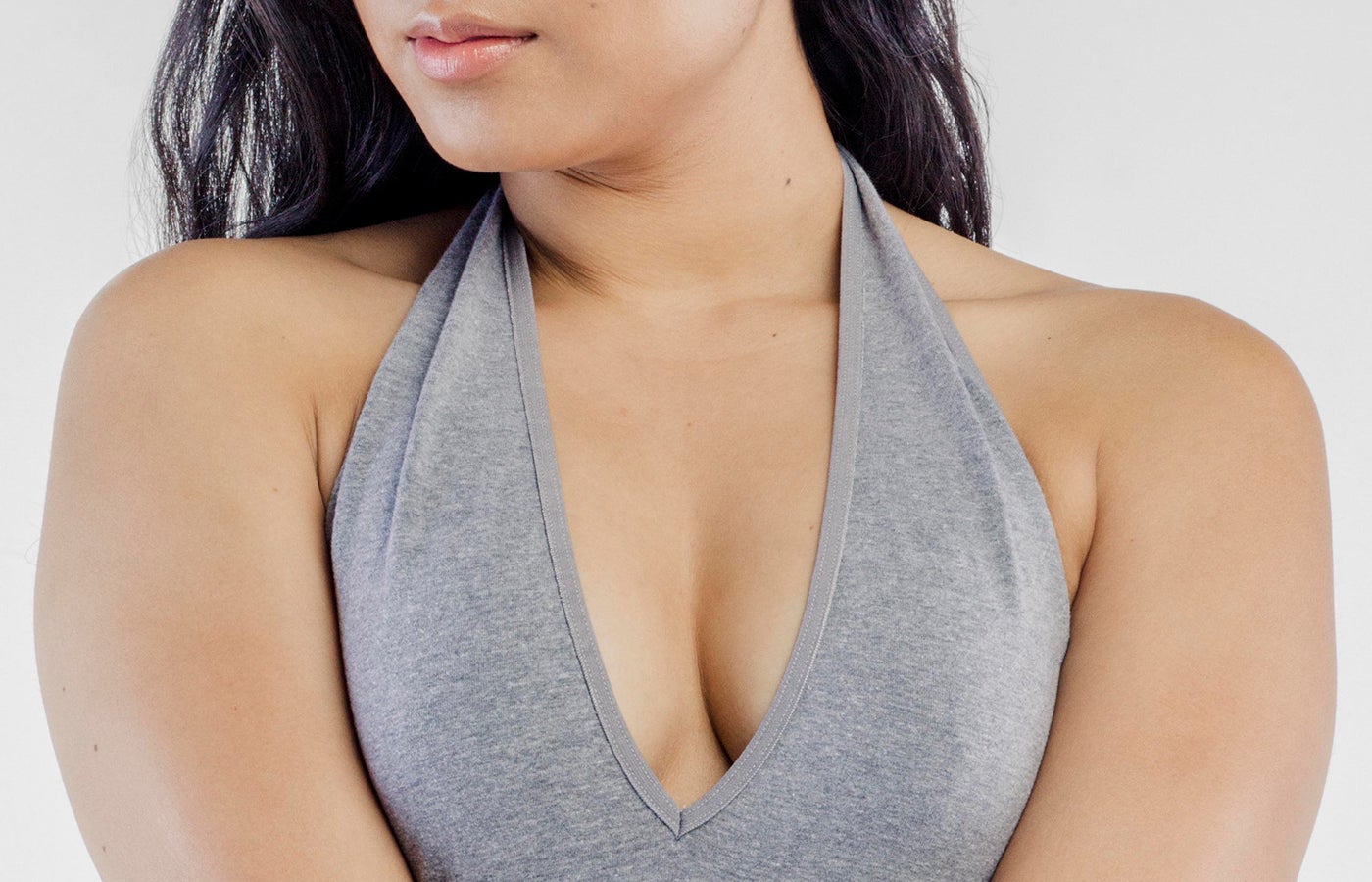BEFORE & AFTER PHOTOS
SPONSORED
Breast implants before and after photo courtesy of Dr. Jason Altman, board-certified plastic surgeon in Miami, Florida. Results may vary.
Breast implants before and after photo courtesy of Dr. Jason Altman, board-certified plastic surgeon in Miami, Florida. Results may vary.
Breast implants before and after photo courtesy of Dr. Jason Altman, board-certified plastic surgeon in Miami, Florida. Results may vary.
Saline or silicone gel breast implants can enhance your breast size and shape. In cases of breast reconstruction after a mastectomy or lumpectomy, they can also help rebuild the breasts.
American plastic surgeons Thomas Cronin and Frank Gerow invented the first silicone breast implants in 1961, and Timmie Jean Lindsey of Texas became the first woman to undergo breast augmentation with the Cronin-Gerow implant in 1962. In the decades since, breast implant surgery has become one of the most popular plastic surgery procedures worldwide.
However, these medical devices have also courted controversy as they’ve been linked to a number of health concerns. Years of intense scrutiny (including several large-scale studies) have failed to produce conclusive evidence that breast implants cause systemic disease, though the FDA did issue a statement in 2017 confirming a relationship between breast implants (primarily those with textured surfaces) and a rare type of lymphoma called breast implant-associated anaplastic large cell lymphoma, or BIA-ALCL. Learn more about implant safety.
While safety studies are ongoing, breast implant technology has improved dramatically in recent years, with options that look more natural and carry fewer risks.
Today’s implants come in hundreds of sizes, shapes, and compositions that influence the look and feel of your final result.
Pros
- Both silicone gel-filled implants and saline-filled implants can make breasts larger, higher, fuller, and more balanced.
- They can also correct tuberous breasts or reconstruct breasts following a mastectomy.
- Implant placement, size, and shape can be customized to suit your body type and personal preferences, so results can look very natural.
- Breast implant surgery has a 94% Worth It Rating, significantly higher than fat transfer breast augmentation.
- Most RealSelf members who rated the procedure “Worth It” say their results boosted their confidence.
Cons
- Patient concerns about breast implant risks have prompted FDA hearings about their safety. In 2021, the FDA announced stronger safety requirements that prioritize transparent labeling about risks. New actions included a black box warning and “patient decision checklist” for surgical consultations, to help ensure informed consent about risks.
- Along with potential complications like breast implant rupture and leakage, it's also possible to have aesthetic issues like asymmetry, capsular contracture, rippling, or bottoming out (when the implant slides down the chest wall and bulges below the natural breast crease or pulls the breast tissues downward) that require revision surgery.
- Breast implants aren’t expected to last a lifetime. They require surveillance and follow-up visits, and while longevity varies, you’ll likely need to have them replaced at some point.
- Some RealSelf members who said their procedure was “Not Worth It” regretted the size, shape, or type they selected. Others were left with scars or asymmetrical results from their breast augmentation surgery.
An experienced, board-certified plastic surgeon can help you make an informed decision about whether you’re a good candidate for breast implants, or whether another augmentation option might be better for you. As you’re choosing your surgeon, pay close attention to their breast implant before and after photo gallery and patient reviews.
During your initial consultation, your plastic surgeon will help you choose the implant size and shape that are most likely to give you the outcome you want. They’ll also explain the risks and benefits of different types of breast implants, including silicone gel-filled implants vs. saline-filled implants and smooth vs. textured.
Related: 6 Factors to Consider When Choosing Breast Implants
Silicone vs. saline
Silicone implants, which have a silicone implant shell and interior, are used in most breast implant surgeries.
- Highly cohesive silicone breast implants are filled with thick silicone gel.
- Gummy bear implants are denser and firmer, so they hold their shape better over time. They can be round with a smooth shell or teardrop shaped with a textured implant shell that helps prevent rotation or malposition. (More on smooth vs. textured shells below.)
Saline breast implants have a silicone shell filled with sterile saltwater.
- They can be pre-filled or filled after they’re placed, which allows for smaller incisions and scars.
- They’re usually less expensive than silicone options.
- All saline implants have a smooth shell.
Surgeons are frequently asked which type of breast implant feels the most natural. They tend to agree that silicone more closely mimics the weight and feel of natural breast tissue.
Related: Silicone vs. Saline Implants: 5 Things to Know About Picking the Right Type
Textured vs. smooth
According to testimony from the major implant manufacturers at 2019 Food and Drug Administration (FDA) hearings on breast implant safety, 90% of silicone breast implants used in the U.S. have a smooth surface, while only 10% are textured.
- Smooth implants have a slick outer silicone shell, so they move freely within the breast tissue, or the capsule of scar tissue that naturally forms around the implant.
- Textured implants have an irregular surface, almost like soft rubber sandpaper, that attaches to the tissue capsule and makes them less likely to move. Some types are highly textured, while others have a very lightly textured surface.
Textured implants have been thought to be less likely to cause capsular contracture—an abnormally hard capsule of tissue that tightens around the implant, causing deformity and breast pain. However, recent research is conflicting, and many plastic surgeons no longer believe textured implants reliably reduce capsular contracture rates.
Textured surfaces have fallen out of favor since 2019, when the FDA warned of higher rates of association between textured implants and anaplastic large cell lymphoma (BIA-ALCL), a rare cancer of the immune system. However, some surgeons still recommend lightly textured implants, which have been shown to have lower ALCL rates than highly textured implants.
Shape, size, and projection
A growing number of surgeons offer 3D imaging during breast augmentation consultations, which can help you visualize the results of various sizes, shapes, and projections on your own body.
Shape:
- Round implants give more “upper-pole fullness” at the top of the breast (for enhanced cleavage).
- Shaped implants resemble the natural form of the breast—tapered at the top and fuller at the bottom. Shaped implants have textured shells to help keep them in position. They’re also more expensive than round options.
Size:
- Breast implants come in all different sizes, measured in cubic centimeters (ccs). According to Dr. Young Cho, a plastic surgeon in Spring, Texas, 125cc to 200cc can increase the breast by about a cup size.
- Your natural proportions desired results will largely determine your implant size.
- Surgeons advise against going too big, as neck and back pain are common side effects of larger, heavier implants. They can also stretch the breast tissues over time.
Projection:
- An implant’s projection or profile—low, moderate, high—describes how far it extends from the chest wall.
- Your chest dimensions will guide you to your ideal profile.
Related: 5 Things to Know About Choosing the Right Implant Size
- Average Cost:
- $6,987
- Range:
- $3,500 - $12,000
Your breast implant cost will depend on several factors, including the type of implants you get, your surgeon’s level of experience, where the surgery is performed, and what kind of anesthesia you have.
When performed as an elective cosmetic surgery, a breast implant procedure is not covered by insurance.
Most providers offer payment plans or accept financing options, such as CareCredit, to help make it more affordable.
See our complete guide to breast implant costs
Prior to your procedure, share your entire health history with your plastic surgeon. They may require you to take medical tests to ensure that you’re healthy enough for surgery.
Related: The 6 Most Common Reasons a Plastic Surgeon Will Turn You Down for Breast Augmentation
Along with helping you choose your implants, your surgeon will discuss whether to place them under or over the chest muscle, and advise you on incision location.
Your surgeon should also give you a complete list of recommendations on how to prepare for surgery. It may include:
- not smoking for at least two weeks before your surgical procedure
- avoiding supplements that may increase bleeding for several days pre-op
- asking someone you trust to give you a ride home and care for you for the first few days after your procedure
To ease recovery, RealSelf members recommend:
- picking up all medications beforehand
- having ice packs, tops that button or zip up the front, and easy-to-prepare food ready
- lining up childcare (and potentially pet care) for at least the first week of your recovery
This hour-long, outpatient surgery is performed under general anesthesia or local anesthesia with IV sedation (twilight anesthesia).
Once the anesthesia has taken effect, your surgeon will make an incision, using one of these techniques.
The inframammary technique:
- Short (1- to 2-inch) incisions are made under each breast, slightly above the crease.
- It’s the most popular technique because it gives your surgeon the clearest view of the breast tissue and muscles as they're placing the implant.
- This location is thought to carry the lowest natural bacterial load, which curbs complications.
- Scars are hidden within the crease.
Periareolar incisions:
- These are made on the lower edge of the areola, where the darker pigmentation meets your natural skin tone.
- Cutting through the bacteria-rich milk ducts can increase the risk of complications like capsular contracture.
- There is a limit to the silicone implant size that can be placed with this technique.
Transaxillary incisions:
- Incisions are made within the armpit, so there's no scar on the breast itself.
- This is an endoscopic technique—your surgeon will create a pocket and place the implant using a tiny camera for guidance.
- Some surgeons caution that there's a higher chance of bleeding and trauma with endoscopic implant placement, simply because it's more difficult for them to see what they’re doing.
- As with periareolar incisions, bacteria native to this area can be a concern.
- There's also a limit to the size of silicone implant that can be placed through the armpit.
The transumbilical or TUBA breast augmentation technique
- Only saline implants can be placed using this method.
- A single incision is made in the belly button.
- With this endoscopic procedure, the saline implants are brought up to each breast via a tunnel under the skin and filled once in place.
- This option is rarely used because it lacks control and precision.
- It has the advantage of being nearly scarless.
Once the incisions are made, your surgeon creates a pocket in the breast tissue and inserts the implants. Most use a no-touch placement technique, aided by a Keller funnel, to minimize bacterial contamination and future complications.
Most surgeons place the implant either above or below the pectoralis major muscle, though some prefer placement under the fascia. Each method has its pros and cons:
Over-the-muscle (subglandular) implant placement
Pros:
- This placement is less invasive, with a shorter recovery.
- For patients with very mild sagging, it may help avoid the need for a breast lift.
Cons:
- The implant is more visible under the skin (especially in lean patients), which can look less natural.
- Mammographic imaging can be more obscured and difficult to interpret.
- It may pose a greater risk of capsular contracture, the most common breast implant complication.
Under-the-muscle and fascia (submuscular) placement (aka dual plane)
Pros:
- Compared to subglandular placement, the result of submuscular placement usually looks softer and more natural.
- Mammogram imagery is easier to interpret.
- It’s associated with a lower chance of capsular contracture.
Cons:
- This is a more invasive procedure with a longer recovery and more post-op pain.
- It can lead to what's called animation deformity, a change in breast shape when the pectoralis muscles flex.
Under-the-fascia (subfascial) placement
Pros:
- According to a 2020 retrospective review published in the Aesthetic Surgery Journal, this placement was associated with no animation deformity.
- The same review notes that it also has an “extremely low rate of capsular contracture.”
Cons:
- This option is even more invasive than subglandular placement.
- While this technique was developed in 2001, it’s still relatively uncommon, so your surgeon may not offer it.
After placing your implants, your surgeon will create layers of interior stitches to support your breast tissue.
They may also inject a long-acting analgesic, such as Exparel, into the muscle, to reduce post-op discomfort and eliminate the need for narcotics. Surgical drains are sometimes placed to remove fluid during healing.
When you’ve recovered from the anesthesia, you’ll head home with your breasts wrapped in dressings and a supportive bra.
Recovery time ranges from a day to a week, depending on the specifics of your procedure and your surgeon’s technique.
Surgeons who offer "rapid recovery breast augmentation"—which sounds like a marketing gimmick but is actually a proven stepwise approach, rooted in science—emphasize the importance of minimizing bleeding and trauma to the tissue during implantation, to reduce post-surgery inflammation, pain, and potential infection.
A few things to note:
- Your breasts will be swollen and sore for the first few days, so your surgeon might prescribe pain medication, muscle relaxers, or sleep aids.
- Surgical drains will need to be removed one to two weeks after surgery.
- You’ll need to avoid strenuous activity, including lifting more than 10 pounds, for as little as two weeks or as many as 12, depending on how you’re healing.
- Surgeons often encourage patients to shower the day after surgery and begin practicing range-of-motion exercises with their arms and shoulders.
- You’ll have to wear a special supportive bra for at least six weeks and mind your incisions, to avoid separation or infection.
After incisions have healed, you can apply a silicone gel, like Biocorneum, to reduce discoloration and flatten raised scars.
You’ll see the change in size and shape right away, but it takes time for your tissue to settle, your muscles to relax, and your breasts to drop and soften into the intended shape and feel.
Breast implants tend to sit high on the chest after surgery before they “drop and fluff.” Most of the dropping will happen within the first three months, but it can take six months for a year to see your final result.
Conventional wisdom used to dictate replacing implants every 10 years. Most plastic surgeons now say that unless you have a complication or want a new size, style, or technology, there’s no need to swap them out on a specific timetable.
All of the major implant manufacturers in the U.S. offer warranties, with a lifetime guarantee in the case of rupture. See our complete guide to implant warranties.
Some of the risks of breast implant surgery, such as anesthesia reactions, bleeding, infection, and pain, are the same for any major surgery.
Others are particular to breast implants. During your consultation, your board-certified plastic surgeon should walk you through a full checklist of risks and potential complications, including:
- Capsular contracture
- Bottoming out
- Rippling
- Rupture and leakage
- Changes in nipple sensation
- Breast pain
- Symmastia (aka “uniboob”)
- BIA-ALCL, a rare lymphoma associated with textured implants, which presents as persistent swelling and pain
- Breast implant illness
Some of these complications may require surgical implant removal, with or without replacement.
The FDA outlines a thorough list of potential breast implant complications on their site. You can also find a complete list of complications, along with complication rates for each specific brand of implant, in the updated patient labeling for all FDA-approved breast implants.
In recent years, doctors have seen more patients complaining of breast implant illness (BII). This concern has gained prominence due, in large part, to social-media support groups for patients alleging that their implants caused myriad health problems.
BII is not a recognized medical diagnosis, and there’s no way to test for it, but commonly cited symptoms include fatigue, "brain fog," joint and muscle pain, hair loss, weight changes, and anxiety/depression, per the FDA.
Regular implant surveillance is essential to breast health. To help detect silicone implant ruptures (often called “silent ruptures” because they’re not immediately apparent), the FDA recommends regular screenings via ultrasound or MRI.
You'll also still need regular mammograms to screen for breast cancer. When you schedule, mention that you have implants and ask if the staff is experienced and the facility is equipped to accurately assess your breast health, without risk of rupture.
They can, in some cases. The most serious potential risk with implants that have a textured silicone shell is breast implant-associated anaplastic large cell lymphoma (BIA-ALCL), a rare cancer of the immune system that’s typically found in the scar tissue and fluid around the implant.
As of March 2023, approximately 418 suspected or confirmed U.S. cases of BIA-ALCL have been reported, according to the American Society of Plastic Surgeons (ASPS). At least 1,355 cases have been identified globally, per the ASPS.
Considering that over 10 million women have implants, the risk is believed to be low (between 1 in 3,817 patients and 1 in 30,000, according to ASPS), but some patient advocates argue that these rates are underreported.
In response to a request by the FDA, Allergan issued a worldwide recall of its Biocell textured breast implants, which were most highly associated with BIA-ALCL, in July 2019.
To help reduce your risk of ALCL, talk with your plastic surgeon about “microtextured” or smooth implant options.
FDA warns of new types of cancer linked to breast implants
In September 2022, the FDA issued a statement alerting the public to new types of cancer associated with both smooth and textured breast implants: breast implant associated squamous cell carcinoma (BIA-SCC) and various lymphomas (other than BIA-ALCL).
In March 2023, the agency released an update, stating: “The FDA is aware of 19 cases of SCC in the capsule around the breast implant from published literature. There have been reports in the literature of deaths from progression of the disease. While the FDA continues to believe that occurrences of SCC in the capsule around the breast implant may be rare, the cause, incidence and risk factors remain unknown.”
The agency notes that the majority of these SCC cases involved swelling and/or pain of the breast. Other reported symptoms included lumps and skin discoloration.
If you become pregnant after getting breast implants, it’s still possible to breastfeed in most cases.
“Whether you have your implants placed subglandularly or under the muscle, neither should interfere with your ability to breastfeed,” says Boston plastic surgeon Dr. Sean Doherty.
It’s possible for milk ducts to be damaged if you combine breast augmentation with nipple surgery, so wait on that until after breastfeeding.
Pregnancy and subsequent weight loss or gain can also affect breast size and shape. To preserve your results, it’s best to be at a stable weight and not planning on a pregnancy within two years of breast surgery.
- Breast lifts reshape sagging or uneven breasts that may have been affected by aging, pregnancy, or weight loss.
- Fat transfer breast augmentation involves removing fat from your hips, thighs, or stomach with liposuction and moving it to your breasts to enhance their size and shape. “The benefit to this method is that you’re using your own tissue to add volume to your breasts,” says Dr. Jerome Edelstein, a Toronto plastic surgeon. “The drawback is that you can’t get as much enhancement as you can with an implant.” Fat transfer can augment breasts one to two cup sizes. It also comes with some body contouring benefits, from the liposuction that's done to harvest the fat. Fat transfer is usually more expensive than implants because it requires the additional step of liposuction.
As you're deciding on your surgeon, look for breast implant pictures that show proportional, natural-looking results, with no visible scars.
The breast implant photos in our gallery have been shared by the surgeon who performed the procedure, with the patient's consent.





